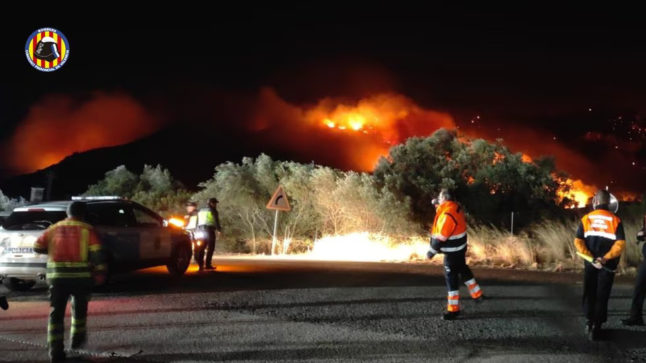The blaze erupted on Thursday near the village of Montichelvo in the coastal region of Valencia and has so far affected up to 1,400 hectares (3,500 acres), emergency services said on X, formerly Twitter.
Over 850 people were evacuated from the municipalities of Terrateig, Castellonet de la Conquesta and other residential areas, including the residents of a mental health centre in the village of Ador, local officials told public television TVE.
📹Vídeo resum dels treballs d’extinció @BombersValencia anit a #IFMontitxelvo.
🚒Nit sense treva i molt complicada per a tot l’operatiu d’extinció per les intenses ràfegues de #vent, que han arribat després d’un dels mesos d’octubre més secs de les últimes dècades pic.twitter.com/FPyoMbNPZd
— Bombers Consorci VLC (@BombersValencia) November 3, 2023
Wind gusts of up to 120 kilometres (75 miles) an hour were hampering efforts to battle the blaze, they added.
It “started with a small fire” but as “the wind has blown all day leading it spread with great speed” Valencia government minister Pilar Bernabé told journalists.
#IFMontitxelvo. Durant tota la nit @BombersValencia ha seguit treballant amb un ampli dispositiu d’extinció, que seguix ara de matí amb els relleus corresponents.
📸Fotos dels treballs d’extinció i PMA d’esta nit pic.twitter.com/5Jap782F2r— Bombers Consorci VLC (@BombersValencia) November 3, 2023
Up to 2,000 hectares of land have been burnt in 19 hours, leading authorities to deploy two hydroplanes to fight the blaze.
Spain was lashed by strong winds on Thursday as Storm Ciarán battered Western Europe, causing at least 10 deaths including that of a 23-year-old woman who was fatally struck by a tree that toppled in Madrid.
READ MORE: Storm Ciarán’s 150km/h winds cause havoc across Spain



 Please whitelist us to continue reading.
Please whitelist us to continue reading.
Member comments